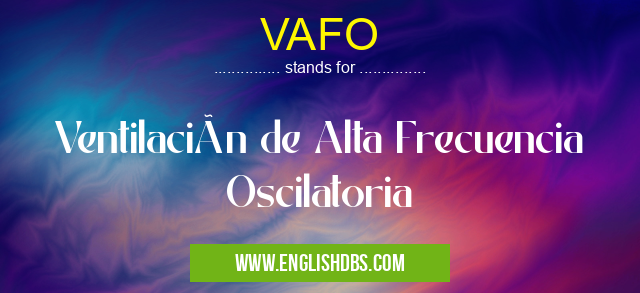What does VAFO mean in SPANISH
VAFO (Ventilación de Alta Frecuencia Oscilatoria) is an advanced respiratory support technique that involves delivering small, rapid, and oscillating breaths to the lungs. It is typically used for critically ill patients with severe respiratory failure who require mechanical ventilation.

VAFO meaning in Spanish in International
VAFO mostly used in an acronym Spanish in Category International that means Ventilación de Alta Frecuencia Oscilatoria
Shorthand: VAFO,
Full Form: Ventilación de Alta Frecuencia Oscilatoria
For more information of "Ventilación de Alta Frecuencia Oscilatoria", see the section below.
» International » Spanish
Mechanism of Action
VAFO utilizes a piston-driven ventilator to generate high-frequency oscillations at frequencies ranging from 5 to 15 Hz. These oscillations create a unique breathing pattern that differs from traditional mechanical ventilation. The rapid oscillations provide:
- Enhanced gas exchange by promoting alveolar recruitment and ventilation-perfusion matching
- Reduced airway resistance due to the oscillating motion of the respiratory system
- Improved mucus clearance and decreased risk of pulmonary atelectasis
Indications
VAFO is commonly used in the management of:
- Severe Acute Respiratory Distress Syndrome (ARDS): ARDS is a life-threatening condition caused by widespread lung inflammation and fluid accumulation. VAFO can improve oxygenation and reduce the need for extracorporeal membrane oxygenation (ECMO).
- Neonatal Respiratory Distress Syndrome (RDS): RDS is a respiratory condition affecting premature infants that results from surfactant deficiency. VAFO provides gentle and effective ventilation, preventing lung damage and promoting lung development.
- Post-Operative Respiratory Failure: VAFO can assist patients with respiratory distress after complex surgeries that require prolonged mechanical ventilation.
Benefits of VAFO
- Improved oxygenation and ventilation
- Reduced airway pressures and lung injury
- Suppression of inflammatory response
- Enhanced surfactant production
- Improved patient comfort and tolerance
Essential Questions and Answers on Ventilación de Alta Frecuencia Oscilatoria in "INTERNATIONAL»SPANISH"
What is High-Frequency Oscillatory Ventilation (HFOV)?
HFOV is a mechanical ventilation technique that uses low tidal volumes and high respiratory rates to provide ventilation to patients with severe respiratory failure. It is commonly used in newborns and infants with respiratory distress syndrome (RDS) or other conditions that require high levels of respiratory support.
How does HFOV work?
HFOV uses a piston-driven ventilator to deliver gas oscillations at frequencies typically between 3 and 15 Hz. These oscillations generate pressure waves that move through the airways and alveoli, providing ventilation without the need for large tidal volumes.
What are the advantages of HFOV?
HFOV has several advantages over conventional ventilation techniques, including:
- Reduced risk of ventilator-induced lung injury (VILI) due to lower tidal volumes.
- Improved oxygenation and ventilation-perfusion matching.
- Decreased airway pressure and resistance, reducing the workload on the respiratory muscles.
What are the disadvantages of HFOV?
HFOV also has some disadvantages, such as:
- Increased risk of air leaks and barotrauma due to high airway pressures.
- Difficulty in monitoring lung mechanics and gas exchange.
- Potential for excessive sedation and muscle relaxation.
When is HFOV typically used?
HFOV is primarily used in neonates and infants with severe respiratory failure, particularly in cases of RDS, meconium aspiration syndrome, and congenital diaphragmatic hernia. It may also be used in adults with acute respiratory distress syndrome (ARDS) or other conditions requiring high levels of ventilatory support.
How long can a patient be on HFOV?
The duration of HFOV therapy varies depending on the patient's condition. In neonates, HFOV may be used for several days or weeks. In adults, HFOV is typically used for shorter periods, such as during the acute phase of ARDS.
What are the complications associated with HFOV?
Potential complications of HFOV include:
- Air leaks (e.g., pneumothorax, pneumomediastinum)
- Barotrauma (e.g., pulmonary edema, hemorrhage)
- Oxygen toxicity
- Hypotension
- Arrhythmias
Final Words: VAFO is a valuable respiratory support technique that has revolutionized the management of severe respiratory failure. It provides benefits over traditional mechanical ventilation, improves patient outcomes, and reduces the risk of long-term pulmonary complications. VAFO remains a cornerstone of critical care medicine, offering hope to patients with life-threatening respiratory conditions.
